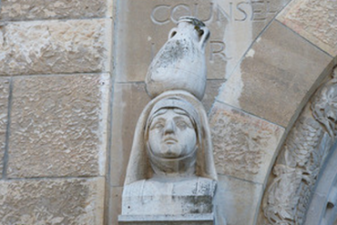
Character vs. flash: An old building in the city center, and a shiny, new Aroma.
What gives a city its particular character? Is it the city’s architecture, its parks and open spaces, its scents, its people?
An article in Ha’aretz’s Real Estate section last week did a pretty good job of conjuring up downtown Jerusalem by describing its shops: “You can’t mistake these stores. They look like they’re out of a movie about the 1950’s. Next to a shiny Castro, Golf or Fox outlet you see a pole from which hang nightgowns and 10 NIS undershirts, or a grimy metalwork shop showcasing a broken-down hot-water boiler, with a mess of tar affixing it to the ground. Or a locksmith or a backgammon club. Until half a year ago Nahalat Shiva Street featured a ceramicist making clay pots for a throwback era.”
Not exactly flattering, but a pretty accurate picture. Like it or not, all of those small, old, “hole in the wall” shops are an integral part of the city’s character and identity. However, the author of these lines, Ranit Nahum-Halevy, is not trying to paint a poetic picture of the city center, she is describing a problem, and the above lines are followed by the rhetorical question: “What can the city do?”
The problem, as Nahum-Levy describes it, is this: while the authorities are investing billions in the light rail project and generally trying to upgrade the city center, a significant proportion of the buildings downtown are in terrible shape, and are not likely to be fixed up any time soon. Worse still, much of the downtown economy’s development has been frozen in time. The reason for this stagnation is the “protected tenant” status of some 30% of the merchants downtown. A form of rent control left over from decades ago, protected tenant status means that shop owners pay landlords rents way below market rate (some 200-500 shekels a month) for their shops, but are not allowed to make any significant changes to their shops without losing their status. A real catch 22.
This being an article in the Real Estate section, Nahum-Levy spends the rest of the piece discussing prices, regulations and policy options. Implicit in the article is the understanding that the old must make way for the new; the city must progress.
The article notes that an organization called the Movement to Strengthen Jerusalem is working to bring about a body to mediate between protected tenants and their landlords, in order to expedite the development of the city. So, assuming that the protected tenant merchants and their landlords eventually come to an agreement, possibly even one which gives the merchants relatively fair compensation, what will that mean for the city center? All of those old shops, their displays, proprietors and customers will no longer be there. But what will take their place in all of that empty retail space in the city center?

Mamilla today – commercialization in place of character.
The recently redeveloped Mamilla area, just next to Jaffa Gate, may provide a clue. Like the city center, Mamilla was once an area overflowing with history and character, and hosted a variety of different activities and people. However, the city decided to redevelop the area, and lots of money was invested in its reconstruction.
Today, Mamilla is just another mall, with the same old retail chains, security guards checking bags and all of the charm of a duty-free store at an airport. All of the area’s character and identity have been commercialized and sterilized beyond recognition.
A city needs a mix of new and old buildings, locally-owned businesses and chains, wealthy and working class residents to be vital. But just as we should think twice before accepting the city’s plans to demolish hundred year old buildings in order to erect bland skyscrapers that add nothing to the urban landscape, perhaps the time has come to ask what kind of city center Jerusalem should have in the future – a unique, varied, human landscape, or a strip mall of generic stores and chain cafes.



